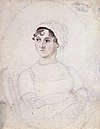The Beautifull Cassandra
The Beautifull Cassandra [ and tells the story of a young woman who sets off into the world to make her fortune.
Style
Austen creates the characters and pastiche without authorial embellishment, in a brief work compressing twelve chapters into three pages.[2] She sets the tone for this style in a dedication – "to Miss Austen" – that parodies flowery literary praise: "Madam, You are a Phoenix [...] Your person is lovely [...] your conversation is rational and your appearance singular" .[3]
Austen then progresses to a story in which the
This small character has her own being, both within the text and on her own – one that reflects much of the life that would be brought to Austen's later characters: her mischievousness, and even delinquency,[7] are especially typical of Austen's adolescent work, with extreme behavior and self-indulgence providing the prevailing tone. Thus, for example at a pastry-shop, Cassandra “devoured six ices, refused to pay for them, knocked down the Pastry-Cook and walked away”, concluding to herself at the end of all her similarly delinquent adventures that“ 'This is a day well spent“.[8]
Later influence
- In her dedication to Cassandra of her unfinished novel Catherine, or The Bower, Austen begins, “Encouraged by your warm patronage of The Beautiful Cassandra....”.[9]
- Lydia Bennet in Pride and Prejudice carries on some of the anarchic and transgressive energy of the beautiful Cassandra.[10]
See also
References
- ^ S. Gilmartin, Ancestry and Narrative in 19thC British Literature (1998) p. 10
- ^ N. Tyler, The Friendly Jane Austen (2001) p. 91
- ^ Jane Austen, The Beautifull Cassandra (Sono Nis Press 1993) p. 258
- ^ Jane Austen, The Beautifull Cassandra (Sono Nis Press 1993) p. 258
- ^ S. Gilmartin, Ancestry and Narrative in 19thC British Literature (1998) p. 11
- ^ I. Collins, Jane Austen (1998) p. 88
- ^ J. Heydt-Stevenson, Austen's Unbecoming Conjunctions (2016) p. 90
- ^ Quoted in E. Copeland ed., The Cambridge Companion to Jane Austen (Cambridge 1997) p. 92
- ^ Quoted in C. Harman, Jane's Fame (Edinburgh 2009) p. 14
- ^ J. Heydt-Stevenson, Austen's Unbecoming Conjunctions (2016) p. 93
Further reading
- Austen, Jane (1996). Peter Washington (ed.). Sanditon and Other Stories. New York: Alfred A. Knopf; Everyman's Library.
- Austen, Jane (1993). The Beautifull Cassandra. Sono Nis Press. ISBN 1-55039-041-4.

